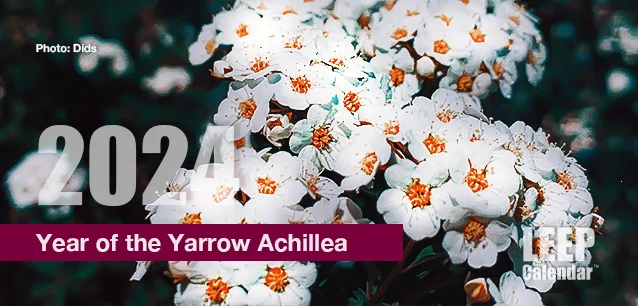 AD
AD
Today is: December 23
Scroll to explore events active on this date.
Additional Events on LEEP
LEEP INK FEATURES

August? Absolutely!
In August, we live through the Dog Days of Summer. It's hot and often humid, and those who can leave for better climates do. Down south, winter is in full force. August is also known as "the ...

In The Heat of July: July 2025 Events
Is it hot enough (or cold enough if you're below the equator) for you yet? There is actually a day for that! Like every month, I pick a diverse collection of events you may or may not know about. This ...

May Blooms: Events in May 2025
Along with October, May is one of the most densely packed months of the year. It's before the summer humidity and the last whole month of the school year. The weather is warming in t...
About 2024 Herb of the Year, Yarrow Achillea.
Ends: Dec 31, 2024
DESCRIPTION:
Since 1991 the International Herb Association has chosen an herb or spice to represent that year. 2024 is the year of Yarrow Achillea.
Yarrow, scientifically known as Achillea, is a genus of flowering plants in the family Asteraceae. The genus receives its name from the Greek mythological hero Achilles, who is said to have used yarrow to treat his soldiers' wounds during the Trojan War. Yarrow plants are native to temperate regions of the Northern Hemisphere, including Europe, Asia, and North America.
Yarrow is a hardy perennial herb known for its feathery, aromatic leaves and clusters of small, daisy-like flowers. The flowers can be white, yellow, pink, or red, depending on the species and cultivar. Yarrow plants typically grow to a height of 1 to 3 feet (30 to 90 centimeters) and create excellent ground cover.
In terms of cultivation, yarrow is relatively easy to grow. It prefers well-drained soil and can tolerate various conditions, including dry or sandy soil and full sun to partial shade. Yarrow plants are also known for their drought tolerance and ability to attract pollinators like bees and butterflies.
Yarrow has a long history of medicinal use. The plant contains various compounds, including volatile oils, flavonoids, and tannins, contributing to its medicinal properties. Traditionally, yarrow has been used to treat multiple ailments, including digestive issues, fever, inflammation, and wound healing. It is often used topically as a poultice or salve to help stop bleeding and promote the healing of cuts and bruises.
Beyond its medicinal uses, yarrow is also valued for its ornamental qualities. Many gardeners appreciate yarrow's attractive flowers, which can add color and texture to gardens and flower arrangements. Numerous cultivated varieties are available, offering a wide range of flower colors and growth habits.
In folklore and symbolism, yarrow has been associated with divination, love, and protection and has been used in various rituals and ceremonies throughout history.
Overall, yarrow (Achillea) is a versatile plant with medicinal and ornamental value. Its attractive flowers, easy cultivation, and historical significance make it popular among gardeners and herbalists.
VIDEOS
SUPPORTING DOCUMENTS
Currently, this event does not have supporting documents.
ADDITIONAL IMAGES
Currently, this event does not have supporting images.
Where would you like to go now?
 AD
AD


/footer-logo.svg)
